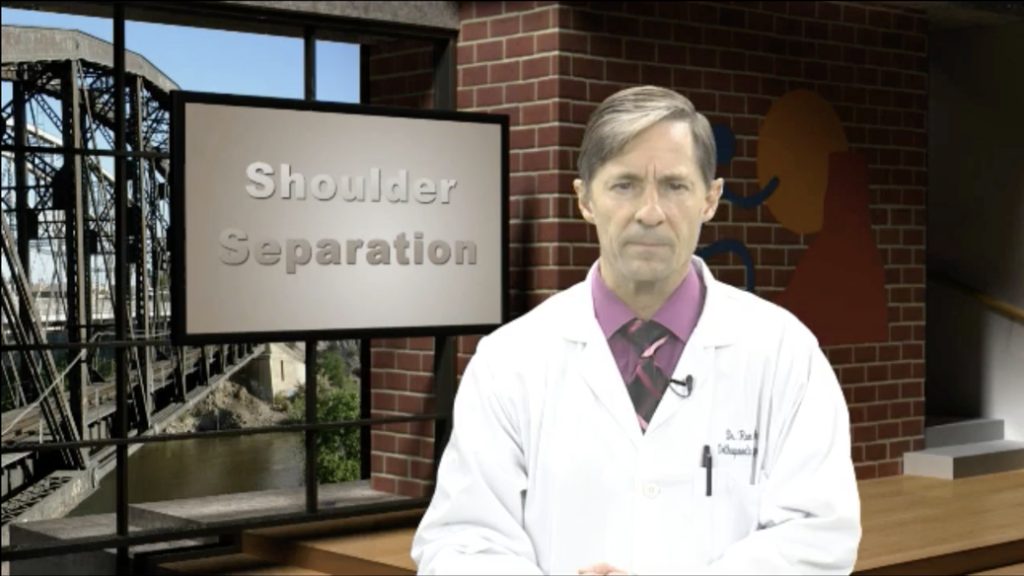Shoulder Separation | Treating Conditions of the Shoulder
December 14, 2022
Hello and welcome to Yuma Health and Happenings. I’m Dr. Ron Clark, Orthopedic Surgeon and founder of The Bone and Joint Center of Yuma. Today I want to talk about the shoulder separations and potential treatments for this condition.
Learning About the Shoulder
The shoulder is comprised of three separate bones, the arm bone, the shoulder blade, and the collar bone. The shoulder is connected to the rest of the body by the inner end of the collar bone and supported by muscles that connect to the neck and upper back. The shoulder blade is completely covered by muscles and lies on the back of the rib cage.
The major joint of the shoulder is where the arm bone and the shoulder blade meet. The end of the collar bone also connects with the shoulder blade at a different location–and is also a flexible joint.
The fact that the shoulder blade can glide over the rib cage makes for a third joint and increases the movement that our arms can make. The surface covering the arm bone and shoulder blade socket is called joint cartilage and is 70% water. This surface allows the two ends of the bone to move smoothly over each other.
The Link Between Movement and Injury
Because the upper end of the arm bone is round and the shoulder blade bone forms a shallow cup, the shoulder is considered a ball and socket joint. This explains how we can use our shoulders to move our hands all around our head and body. This ball and socket is also the joint of the body with the greatest amount of movement.
Since the socket side of the joint is much smaller than the arm bone is, a great deal of force and energy can be passed through the muscles and tissues that hold the shoulder together. Many of the common shoulder problems occur around the muscles and the tissues that are supposed to hold the shoulder bones together.
What is a Shoulder Separation?
One of the injuries that causes both pain and deformity in the shoulder is called a shoulder separation. This injury occurs when a fall or collision results in a force that damages and separates the shoulder blade from the collar bone.
The connection between these two bones is known as the acromio-clavicular joint or abbreviated as simply the A-C joint. This kind of injury occurs in sports like football, falls from animals, or even motor vehicle or motorcycle accidents.
With this type of injury, a person will generally have so much pain that they may go to the hospital for prompt evaluation or may try to give it time to heal on its own. X-rays will determine whether the shoulder separation is mild, moderate, or severe. For those with mild or moderate joint separation, the ligaments that connect the shoulder are stretched and the amount of joint deformity is minimal.
With a severe or complete A-C separation, the shoulder blade portion of the acromion will drop down and give the collar bone the appearance of lifting. With mild and moderate injuries, time and gentle exercises are generally all that is needed for a complete recovery.
Shoulder Separation Treatments
For those who have a severe or complete A-C joint separation there is disagreement as to which individuals may benefit from an attempt at surgically reconstructing the damaged ligaments.
For a person to have any benefit from surgery to reconstruct the A-C joint, they must agree to precise cooperation with restrictions that will be placed on the shoulder following surgery. A person who is not able to follow the necessary restrictions on shoulder and hand use following surgery should not be considered a candidate for this operation.
Seeking Surgical Care
If a person wants to have a repair of the severe A-C joint type of separation, then they are best served to undergo it with 90 days of the injury. Waiting longer may make it difficult to completely put the bones back in their original position.
In about 10% of situations, a person with a complete A-C joint separation will begin to experience pain at the joint when surgery has not been performed. A procedure that simply shortens the collar bone can be done at almost any time without losing the ability to decrease shoulder pain.
Is Surgery Right for You?
The biggest drawback to surgery at the A-C joint is that the repair may not hold well and the deformity may return over time. Even if the joint is not treated surgically, most people do not have any real limitations on what they are able to do with the affected shoulder after a severe A-C joint injury. This explains part of the reason why there is a large discrepancy between shoulder experts as to needs surgery.
Even those who are athletes may notice throwing strength and velocity diminish after surgery to correct a severe A-C joint injury. For this reason, advanced throwing athletes may need to anticipate a full year before their recovery is complete.
Obviously, each patient is different, so generalizations related to individual options for care are difficult. It’s best to consider the options with your treating physician. The overall message is that even with significant deformity, most A-C joint injuries will not lead to loss of shoulder function or limit activities or lifestyles in any significant way.
If you’re suffering from a shoulder separation, you can find help from The Bone and Joint Center of Yuma. Our staff will help you on the road to recovery. Get started with treatment by requesting an appointment today.